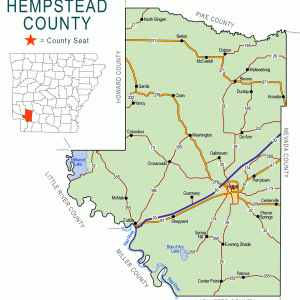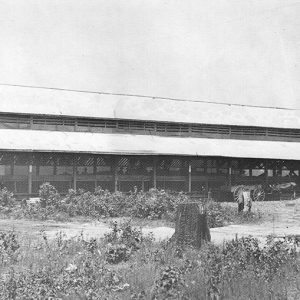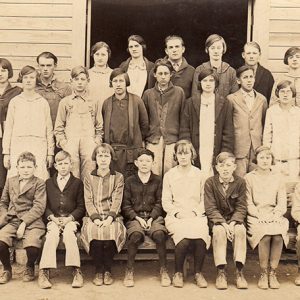calsfoundation@cals.org
McCaskill (Hempstead County)
| Latitude and Longitude: | 33°55’00″N 093°38’30″W |
| Elevation: | 446 feet |
| Area: | 0.74 square miles (2020 Census) |
| Population: | 57 (2020 Census) |
| Incorporation Date: | September 20, 1920 |
Historical Population as per the U.S. Census:
|
1810 |
1820 |
1830 |
1840 |
1850 |
1860 |
1870 |
1880 |
1890 |
1900 |
|
– |
– |
– |
– |
– |
– |
– |
– |
– |
– |
|
1910 |
1920 |
1930 |
1940 |
1950 |
1960 |
1970 |
1980 |
1990 |
2000 |
|
– |
– |
170 |
236 |
122 |
62 |
58 |
87 |
75 |
84 |
|
2010 |
2020 |
|
|
|
|
|
|
|
|
|
96 |
57 |
|
|
|
|
|
|
|
|
McCaskill is a town in northern Hempstead County on U.S. Highway 371. It developed early in the twentieth century after construction of the Prescott and Northwestern Railroad.
Although some of Arkansas’s oldest cities and towns emerged in Hempstead County along the Southwest Trail (an early military road), the northern part of the county remained remote until the start of the twentieth century. Some settlers acquired land and established farms and plantations, including Hezekiah Askew, who came from North Carolina to Pike County around 1848 before going the land office in Washington (Hempstead County) in 1860 and acquiring land around what one day would be McCaskill. His sons James and John purchased adjoining lots around the same time.
The Skirmish at Prairie D’Ane was fought several miles east of Askew’s land in April 1864. This skirmish diverted Confederate troops to defend Washington but allowed Federal forces to claim Camden (Ouachita County).
The Prescott and Northwestern Railroad was organized in October 1890 to move lumber from the forests to sawmills and from the sawmills to markets. By 1894, the Ozan Lumber Company dominated the railroad. The railroad arrived in the future McCaskill area around 1900 and was soon used to transport fruits and vegetables, including peaches, as well as timber. The railroad also carried passengers until 1945.
A Methodist congregation began worshiping in the area in 1898. A post office opened in the area in 1908. It was called Dixon for four years but changed its name to McCaskill in 1912. A sawmill built in Westbrook (Hempstead County) was moved to McCaskill in 1912. It burned in 1919 and was rebuilt the next year before ceasing operation in 1925.
Many of the cotton farmers in the area were diversifying their crops in the early twentieth century, and McCaskill became a center of cantaloupe production with the formation in 1911 of the McCaskill Truck Growers Association, including Martin Askew, Daniel Berryman McCaskill, Edward F. Whiteside, J. N. Rhinehart, James W. Hampton, Perry C. Hayes, and Dee Scott. (This organization may well have been the source of the town’s name.) More than twenty freight cars of cantaloupes were shipped from McCaskill in 1912.
A cotton gin was built in McCaskill in 1914. A store in the community passed through several owners during these years. A second store opened in 1914, joined by a third store in 1918. The Bank of McCaskill opened in 1920. A school also began holding classes for white students in 1914. A school for African Americans operated nearby at Goff Chapel.
McCaskill—located in the Redland Township of Hempstead County—incorporated in 1920. Several new businesses opened, including a hardware store and a drugstore. A café opened in 1926. Over the years, there were five blacksmith shops, twelve barbershops, and a garage to service automobiles. A former stockholder of the bank destroyed the building with dynamite one night in 1924. In 1927, the frame schoolhouse burned, and it was replaced with a four-room brick structure.
Crops began to fail during the Drought of 1930–1931, and the Depression brought further troubles to the community. The bank closed in 1930, and the cashier was convicted for embezzlement. In 1931, the school district was consolidated into Blevins Special School District No. 2. The brick building in McCaskill continued to be used for some time as a junior high school. Road improvements made it possible for rural residents to travel farther to shop, leading more McCaskill businesses to relocate or to close.
In 1942, the Southwestern Proving Ground was established on approximately 50,000 acres between McCaskill and Hope (Hempstead County). Various munitions were tested at the facility, and more than 500 civilian jobs were created. With the end of World War II in 1945, the Southwestern Proving Ground was decommissioned. Some portions of it were adapted to other uses, including the air field that became the Hope Municipal Airport, but much of the land remained empty, unusable due to unexploded munitions.
The population dropped below 100 during the 1950s. In 1955, the last harvest of peaches was carried by the railroad. Other than improvement of the highway, not much happened to bring change to McCaskill. The railroad was acquired by the Potlatch company in 1966 and continued to operate into the 1970s. After 1980, the railroad fell into disuse, and the tracks were removed in 1994.
In the new millennium, the town’s population began to grow again (although it had fallen to 57 by 2020). In the twenty-first century, McCaskill has a post office and a United Methodist church.
For additional information:
“History of Redland Township.” Written by Students of Eighth and Ninth Grades, McCaskill Junior High School, April 1936. Butler Center for Arkansas Studies, Little Rock, Arkansas.
The History of Redland Township, Hempstead County, Arkansas. N.p.: 2015.
Leshe, William M. “The Prescott and Northwestern Railroad: A Geographical Analysis.” Master’s thesis, University of Arkansas, 1977.
Steven Teske
Butler Center for Arkansas Studies
 Hempstead County Map
Hempstead County Map  McCaskill Packing Shed
McCaskill Packing Shed  McCaskill School
McCaskill School 



Comments
No comments on this entry yet.